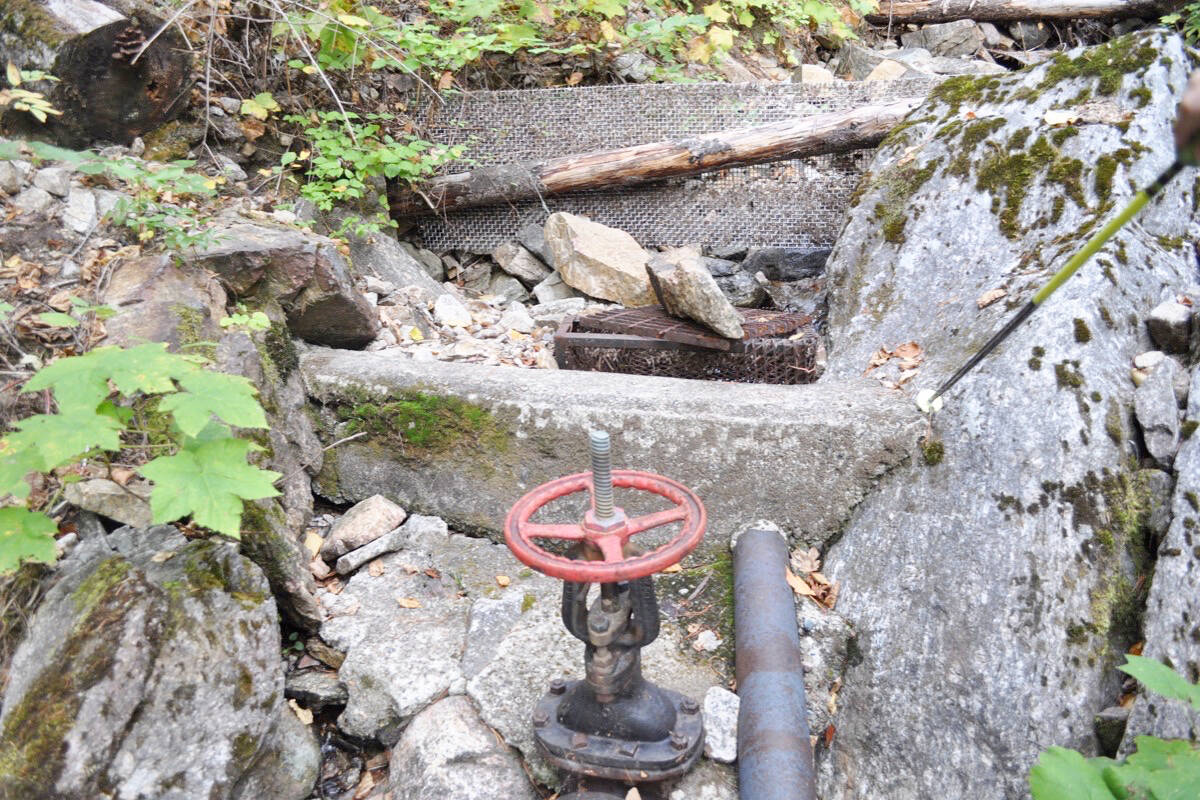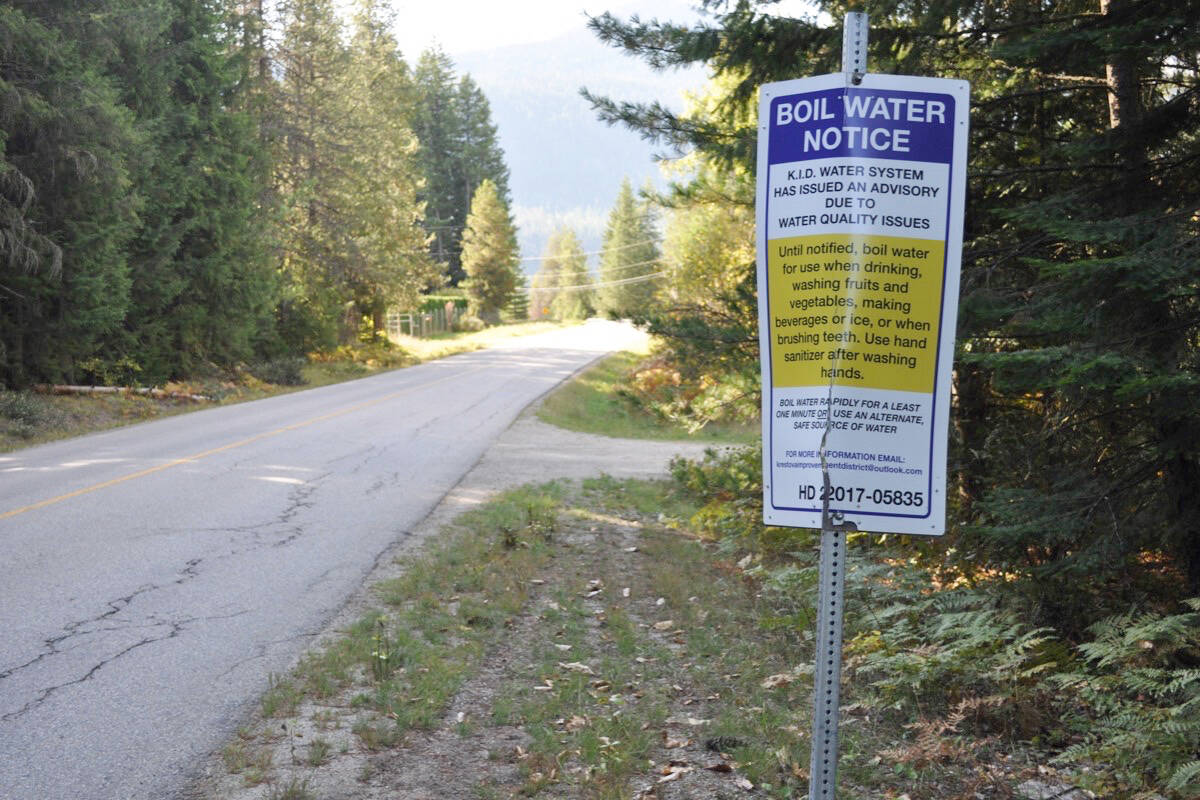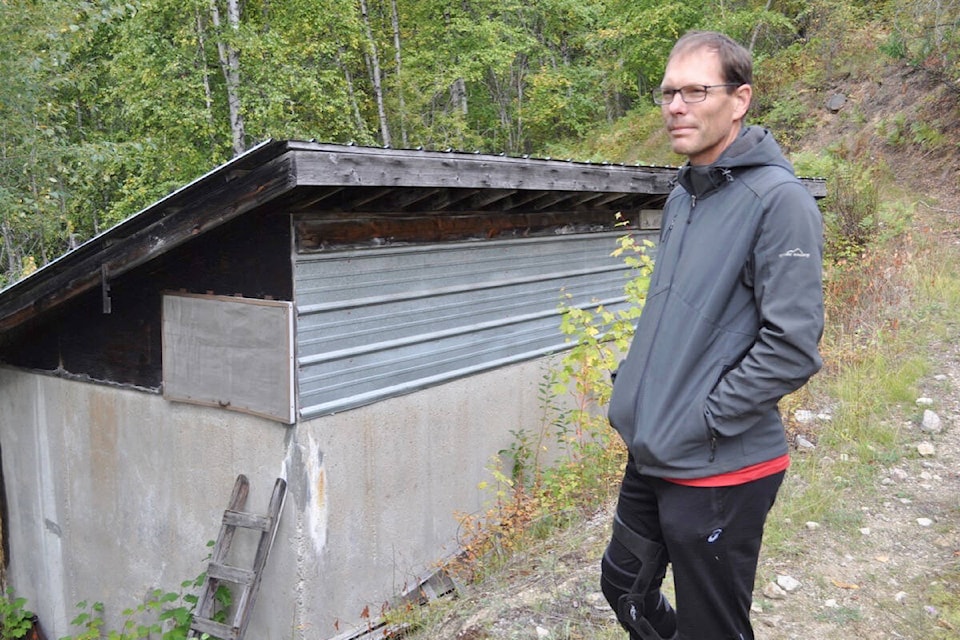Ico de Zwart steps over a PVC pipe where a steady leak drips near the intake collecting Krestova’s drinking water.
Nearby, scorch marks can be seen where residents were forced to use torches to thaw out the frozen pipes and water boxes last Christmas Eve.
Volunteering to help manage a community’s water system, De Zwart has found, is more complicated than just turning on the tap.
“It’s really difficult for us to manage these projects while guys are trying to run their own businesses and do their regular jobs. The people who are involved, they’re also doing a lot of other stuff too. It’s almost a full-time job just to deal with the water supply.”
De Zwart is a trustee with the Krestova Improvement District’s water users group. He’s lived in Krestova, located between Nelson and Castlegar, for 12 years, but only uses the community’s water for irrigation and relies on rainwater collected at his home to drink.
That’s because Krestova has had a boil water notice in place since 1992, one of 28 community water systems in the Kootenays that have had such advisories since the 1990s.
There are 740 drinking water systems in the Kootenays that are registered with Interior Health. A report released in the summer by Selkirk Innovates found 178 public systems in the Columbia Basin-Boundary region were on boil water notices as of June 13 (three systems are within Northern Health’s jurisdiction).
A further 26 were under water quality advisories, which means there is risk to drinking the water but without a boiling requirement. Nine others are currently considered do not consume, where boiling the water would still not make it potable.
Leeza Perehudoff, a research assistant with Selkirk Innovates, said the report highlights aging infrastructure and communities that either can’t, or won’t, pay for upgrades.
“There are a lot of community-owned and maintained water systems where the onus is on small groups of people or volunteers who are maintaining our rural water systems.”
One of those groups is in Krestova, where five volunteers manage the system.
In 2020, a feasibility study recommended $3.6 million in upgrades that would include swapping the current surface water intake for a ground water source. Krestova would also need to replace five kilometres of pipes, add new tanks, disinfection and electricity.
Earlier this year a pump test was done for a new water source in Krestova. De Zwart said the group applied in the summer for a water licence and made an application to Interior Health to have the well designated as a drinking source, but applications can take years to receive approval.
The upgrades make sense. Ground water is a more reliable source that is easier to treat and has cheaper operating costs. But De Zwart said the price tag is too high for the approximately 70 households connected in Krestova to take on alone.
“Any upgrades we do have to be on a path to eventually getting rid of this boil water notice. We can’t deal with it all in one fell swoop. It’d be great if we could just have a magic wand and go look, upgrade done.
“But the reality is that maybe by now it’s a $4-million project. Yeah, that’s not going to happen. There’s just no way.”

Staying under the radar
People would rather not talk about the quality of their drinking water.
The Nelson Star reached out to 11 representatives of community water groups with questions about their water systems. Of those, only one with an ongoing boil water notice — De Zwart — agreed to speak publicly about the issues they face.
Several others, however, spoke to the Star on the condition of anonymity. Their reasons for doing so are often due to community disagreements about the quality of the water, if it should be treated, who is in charge and, of course, who should pay.
Community water systems vary in size. One might deliver water to a handful of houses, another to a place like Bountiful where Interior Health estimates 1,000 people access a service that has had a boil water notice in place since 2000.
The lack of municipal or regional government leadership can lead to inaction on systems in need of upgrades.
One volunteer said their system, which like Krestova has had a boil notice in place since 1992, had to be split off from another community using the same creek because no one could agree on how it should be built. The system is over 50 years old, and the only filtration in place are screens to divert branches and leaves.
That person also cited the E. coli outbreak 23 years ago in Walkerton, Ont., that killed seven people, made 2,300 ill, and led to the community’s utilities manager being sentenced to one year in jail. No volunteer, they said, wants to be the face of a local water system should disaster occur.
But not every group is content to just let the water flow.
In another community with a small system, a volunteer said their group pays for testing but only to ensure there are no new issues. Residents are comfortable with how their water is, even with an advisory, and don’t want to be told otherwise.
“We’re trying definitely to stay under that radar and not start having folks coming out. I was bringing folks up to the spring and they were looking and they were quite appalled because they were coming from these big, more robust systems and cities and they see these rural stuff and they can’t imagine that it could work.”
Rural residents also tend to consider chlorination a dirty word.
For some it is a matter of taste. Untreated water simply tastes better than what is chlorine-treated, even if it comes with the risk of pathogens. For others it is principle. Drinking water should be free of chemicals.
And they definitely won’t pay for it.
“They don’t want chlorination,” said a volunteer. “They’ve felt healthy and happy with their mountain water, better than a lot of cities, arguably. It really depends on who you talk to.”
Longbeach, a small community northeast of Nelson, has operated its own water system since the 1980s. Paul Neave, who is among three volunteers on the Longbeach Water Users executive, said chlorination was introduced five years ago and now the system no longer has an advisory.
But Neave said he tries to keep chlorine levels as low as he can while also meeting Interior Health requirements. That’s what the community prefers.
“It’s probably the taste threshold for a lot of people.”

The invisible part
In 2011, Balfour’s water system became one of the few in the Kootenays to be operated by a regional government.
It had been built in 1947 and was run by the community until it was acquired by the Regional District of Central Kootenay in January 2011. That allowed for the installation of a treatment plant that added ultraviolet disinfection, chlorination and filtration.
Ramona Faust, who was the RDCK’s area director for Balfour in 2011, said the community had managed the system as well as it possible could have for over six decades.
“They were trained, they had an operator, they had a bookkeeper. They were as good as you get for a system that’s run by volunteers, who also have to argue with people who don’t want the water rates to go up. So when that opening came along, Balfour was ready to step in.”
Balfour was one of nine new systems the RDCK added over two years before placing a moratorium on the acquisition of water systems in 2012. It hasn’t taken on any more since.
The Kootenays’ three regional districts operate just 30 rural water systems. Of those, 18 are owned by the RDCK.
Uli Wolf, the RDCK’s general manager of environmental services, said in retrospect the regional district didn’t have the resources prepared to add so many new systems in so short a timespan.
Before the government can take ownership of a community’s water system, Wolf said it needs to assess the existing infrastructure, if lines exist on private properties with easements, and what is required to meet ministry and health authority requirements.
It also requires broad community support, because the costs are higher and often come with necessary upgrades.
“The vast majority of systems, with very few exceptions, are either not compliant, or have a large group of residents who are not willing to pay substantially more than they do right now.”
If they do turn over control, residents also have to prepare for surprise infrastructure costs.
Thirty-seven kilometres of pipes used in RDCK water systems, for example, are made of asbestos. Wolf says the pipes were installed in the 1960s and 70s, and are beginning to crumble. They’ll require replacing in the next 10 years.
“The invisible part is always the hard one, right? That’s the part everybody forgets about. The reservoirs are visible, a treatment plant is visible, a fire hydrant is visible, but the rest in the ground is forgotten about. That is probably in most cases around the 80 per cent mark of the infrastructure that you actually have for a lot of water systems.”
Despite the obstacles, Wolf said there is the possibility the RDCK takes on more community water systems if the demand is there. The board has directed its staff to investigate a possible lifting of the moratorium next year.
Still waters run deep, as do divisions
Community water is an equity issue for Ivor Norlin.
Norlin manages drinking water programs for Interior Health. Ideally, every community has clean water that meets the health authority’s standards. But Norlin acknowledges that is tricky in a region where so many systems are decades old and were only built to flow water as it is from its source to homes.
Those systems weren’t built to meet society’s expectations for potable water in 2023.
“There wasn’t a lot of forethought put into, OK let’s build a system that has the right tax base and financial structure to allow them to build a treatment plant. They were there just to make sure water goes to the houses.”
B.C.’s affordable housing crisis has also complicated the issue. As home ownership and rentals become too expensive in cities, residents are opting to move to more rural communities.
That, Norlin says, is leading to a divide between people who have chosen to live rurally and those forced to. The former typically accept the water system for what it is, can pay for treatment options at their homes, and have the most say in local governance. The latter don’t.
“Those voices are usually very strong within these water users communities and other kinds of governance,” says Norlin. “‘I moved here, I knew what I was taking on, this was my choice, you can’t force me to pay more. You can’t force me to take responsibility for my neighbours.’
“But how many other people in our community are there because of necessity, because that’s where the affordable housing is? Or how many are there because it’s a rental and they don’t want to raise their voice too much because you don’t want to tick off the landlord?”
Norlin doesn’t blame anyone for the state of their water systems. The people who built them are mostly gone now, and current residents have to live with what is in place. He also doesn’t believe in fines or enforcement, which he says don’t address the root issues for poor water quality.
But there’s also no obvious solution to ensuring every community gets the drinking supply it wants within B.C.’s system. Water — who is in charge of it, how it’s delivered and how clean it is — will always be contentious.
“I always say whisky’s for drinking, water’s for fighting.”
Want to check the status of your local water system? Visit https://drinkingwaterforeveryone.ca/advisorymap/.
READ MORE:
• Ktunaxa Nation calls for meetings with Canada, U.S. to address Kootenay watershed pollution
• Canada, U.S., wrap up 19th round of Columbia River Treaty talks
